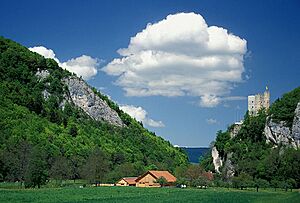Büsserach facts for kids
Quick facts for kids
Büsserach
|
||
|---|---|---|
|
||
| Country | Switzerland | |
| Canton | Solothurn | |
| District | Thierstein | |
| Area | ||
| • Total | 7.55 km2 (2.92 sq mi) | |
| Elevation | 420 m (1,380 ft) | |
| Population
(Dec 2020 )
|
||
| • Total | 2,296 | |
| • Density | 304.11/km2 (787.6/sq mi) | |
| Demonym(s) | Büsseracher | |
| Postal code |
4227
|
|
| Surrounded by | Breitenbach, Erschwil, Fehren, Grindel, Meltingen, Wahlen bei Laufen | |
Büsserach is a small town, also called a municipality, in Switzerland. It is located in the Thierstein district, which is part of the canton of Solothurn. Büsserach is known for its beautiful natural surroundings and its historic castle.
History
Büsserach was first mentioned in official records way back in 1194. At that time, its name was written as Buezherach. This shows that the town has a long and interesting history.
Geography
Büsserach covers an area of about 7.55 square kilometers (about 2.9 square miles). A large part of this area, about 42.4%, is used for farming. This means there are many fields and farms around the town.
Almost half of Büsserach, about 46.2%, is covered by forests. These forests are important for nature and offer great places to explore. About 11% of the land is built up with buildings and roads. This is where people live and work.
The town of Büsserach is found on the eastern side of a valley. This valley leads up to the Passwang Pass, a mountain pass. The municipality includes the main village of Büsserach and the historic Neu-Thierstein Castle.
Coat of Arms
Every town has a special symbol called a blazon or coat of arms. Büsserach's coat of arms shows a golden castle. This castle stands on green hills, all on a red background. The castle on the coat of arms represents the historic Neu-Thierstein Castle.
Population and People
Büsserach has a population of about 2296 people. About 10.7% of the people living in Büsserach are from other countries. Over the past ten years, the number of people living in Büsserach has grown by about 4.7%.
Most people in Büsserach speak German. About 92.2% of the population uses German as their main language. Other languages spoken include Serbo-Croatian and Albanian.
In Büsserach, there are many different age groups. About 9.2% of the population are young children (0-6 years old). Teenagers, aged 7 to 19, make up about 14.7% of the population. Adults between 25 and 44 years old are the largest group, making up about 31.9% of the population. There are also many seniors, with about 10.8% of people being between 65 and 79 years old.
The town has about 754 households. On average, there are 2.5 people living in each home.
The chart below shows how Büsserach's population has changed over many years:

Economy
Büsserach has a low unemployment rate, which means most people who want to work can find jobs. In 2010, the unemployment rate was 2.7%.
The town's economy is divided into three main parts:
- Primary sector: This includes jobs like farming and forestry. About 24 people work in this area.
- Secondary sector: This involves manufacturing and construction. Many people, about 284, work in factories or building things.
- Tertiary sector: This covers services like shops, restaurants, and education. About 239 people work in these service jobs.
Many people who live in Büsserach travel to other towns for work. About 18.4% of workers use public transportation, like buses or trains, to get to their jobs. A larger number, 57.7%, use their own cars.
Religion
Most people in Büsserach are Roman Catholic, making up about 76.3% of the population. Another 10.6% belong to the Swiss Reformed Church. There are also smaller groups of people who follow other Christian churches, Islam, Buddhism, and Hinduism. About 8.69% of the population do not belong to any church.
Education
Education is important in Büsserach. Many adults, about 42.1%, have completed upper secondary education. This is like finishing high school. About 7.8% of adults have gone on to higher education, like university.
The local school system starts with two years of non-mandatory Kindergarten. In the 2010-2011 school year, 33 children were in kindergarten. After kindergarten, students attend six years of primary school. During that same year, there were 131 students in primary school.
For secondary school, students from Büsserach usually go to schools in a nearby town. This means they travel a short distance for their middle and high school education.
See also
 In Spanish: Büsserach para niños
In Spanish: Büsserach para niños






